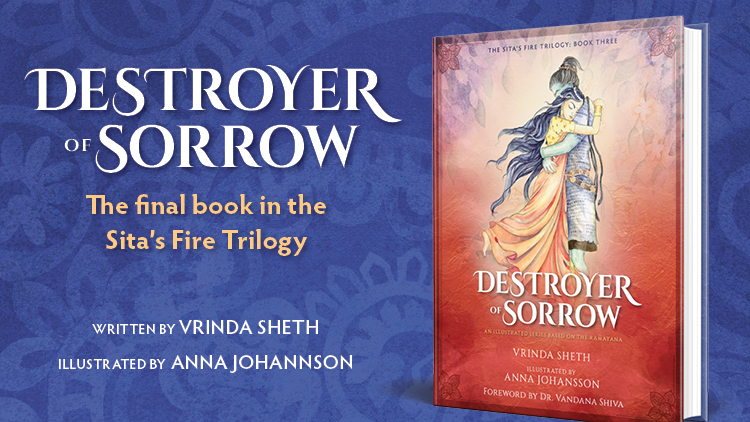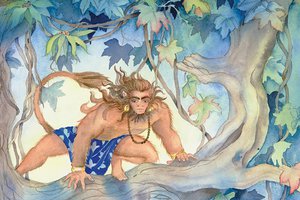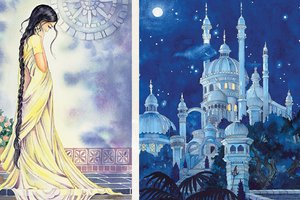Vrinda Sheth Talks About The Final Book of Her Ramayana Trilogy Focusing on Sita’s Perspective
By Madhava Smullen | Mar 21, 2021

Destroyer of Sorrow, the epic conclusion to Vrinda Sheth’s Sita’s Fire trilogy based on the Ramayana, is set to be released by Mandala Publishing on April 20th. Hardbound and 336 pages long, the book features over ninety illustrations by Vrinda’s mother Anna Johansson (Annapurna Dasi) and is the culmination of a decade of work on the trilogy by the mother and daughter team. (Pre-order here: https://sitasfire.com/)
In this final volume, Princess Sita defies all odds to rise above the forces that threaten to consume her and faces her own demons, as well as the terrible Ravana. Meanwhile, Sita’s beloved husband, Rama, and his brother continue their desperate search for Sita. Ultimately, an epic battle between the forces of good and evil ensues, with implications for Sita, and for all of humanity, in the balance.
Alternately told through the perspectives of Sita and Hanuman, Destroyer of Sorrow reveals an entirely new side to this classic saga. Dr. Vandana Shiva writes in her foreword, “Vrinda brings out the agency of Sita in protecting herself, her integrity, and her autonomy while held captive by Ravana.”
Here author Vrinda Sheth talks about Destroyer of Sorrow, her unique approach, her journey throughout writing the trilogy, and how it has changed her life.
ISKCON News: When did each previous book of the Sita’s Fire trilogy come out? Can you summarize what the first two books each covered?
Vrinda Sheth: Shadows of the Sun Dynasty was released in 2016, and Queen of the Elements in 2017. In Book 1, the focus is on the Sun Dynasty, as the title suggests. This is a book of palace intrigues and interpersonal dynamics, in a grand royal setting. This retelling is unique in that we enter the story at a much earlier point than is usually done. The Sanskrit storytelling method often relies on flashbacks in dramatic moments to explain sudden plot shifts. So what I did was to take those flashbacks and write them in “real-time.” In other words, we are with the characters as these crucial events take place, and therefore when the plot escalates, the readers are acutely aware of the dynamics that brought on this shift in tension. Queen of the Elements is set primarily in the jungle and follows the royal trio in their exile. I took time, for example, to develop the relationship between Sita and Lakshmana that then help to explain their interactions in their crisis. As the title suggests, I also devoted time to explore Sita’s supernatural connection to the natural world, being Ayonija, as she is, not born from a womb, but from the Earth herself.
Can you describe the reception from audiences and reviewers to the first two books? So much of my writing process was working with my apprehension (and fear even!) of how our work would be received. Having grown up in the movement, I’ve been steeped in reverence for our scriptures. I was told time and time again to back up anything I said or felt with shastra. The message I received was that anything worth knowing has already been saying and is there in Shastra. So I was very aware of a mood within the ISKCON community that Shastra is beyond scrutiny, and it should never be changed or altered. I could say a lot more about this, as it’s been a huge internal process to follow my inner calling, to choose courage over fear, creativity over conformity, inspiration over depression.
Though certainly, we worship Lord Rama in ISKCON, the Ramayana itself really isn’t a central text (evident in the fact that many ISKCON devotees have never read Valmiki Ramayana. Valmiki’s version is, of course, the one that Srila Prabhupada authorizes in the 9th canto of Bhagavatam where a highly summarized telling appears). Also, the Ramayana is hailed as the Adi Kavi, or first poem, and it is primarily a poetic work. Valmiki was a poet, not a historian, and his work is evocative first, possibly didactic second (There is a really interesting and longstanding effort to establish the Ramayana’s historicity by for example mining the astrological references, of which there are many). I discovered also that for other Vaishnava communities, the Ramayana is their primary devotional text; I found it delightful to read the earliest commentators from the 16th century who go verse by verse and deliver a commentary, just as we have with the Shrimad Bhagavatam.
All this is to say that I was actually expecting a heavy backlash or criticism, and I prepared my heart for that. But to my great surprise, I’ve received such a warm response! Just the other day, one of my elders and most respected teacher Mother Nanda here in Alachua approached me to ask when the final book would be here. She showered me with love and praise, not for the first time. As we spoke more, she did reveal that she initially had been skeptical, but the more she read, the more she was drawn in and convinced by my portrayal of that time, those characters. And this is the greatest blessing to me, that someone so devoted to self-realization and to Krishna consciousness found value in my effort to bring fresh life to the Ramayana.
I had two overarching goals while writing. One, that anyone who knows and loves the Ramayana feels that it’s complementary to what they know, that it expands upon the Ramayan canon. Two, that anyone who doesn’t know the Ramayana will gain smooth access to these timeless legends. These books really are geared more for those who don’t know the Ramayana, the Yoga community for example, or even a young reader interested in Fantasy or Mythology (as the books would be categorized out in the world), so we are happy to have received several awards and positive reviews from Kirkus, among others. With Book 3 finally here, we want to spread the word as much as possible in the Yoga community and beyond.
Can you summarize what this final book, Destroyer of Sorrow, will be about? What will some of the highlights be, and what do you think readers will like about it? As Dr. Vandana Shiva wrote in her foreword to the book, the focus is on Sita as Shakti, her agency, her crucial role in the face-off with Ravana, the embodiment of destructive demonic power. It was in the writing of this book that I had to really confront my assumptions: one, that everything I needed to know would be available in the original, and two, that the story belonged to the male characters. As I came to the end of my first draft of the entire trilogy, I realized how incredibly important Sita is (as well as other female characters, like Manthara, Kaikeyi, and Shurpanakha) and how I had neglected to bring them into focus. In Valmiki’s text, for example, Sita occupies only about 10% of the text, once all the shlokas are counted. Being traditionally raised, I had unconsciously followed this pattern. But I realized strongly then that it would not work because I was the most interested in Sita and the other women, and yet, there was hardly enough there to write half a book about them!
Even among other recent retellings that give Sita voice, Destroyer of Sorrow still is distinct, because I focus specifically on Sita’s time in captivity, her resilience, and her crucial role. There is also an exploration of a more burdensome or heavy theme, which I’d begun in Book 1 itself, and that refers to the societal codes and etiquettes that Rama and Sita had to abide by as royals of the Sun Dynasty. Readers will also enjoy being with Hanuman in his quest to find Sita. Hanuman is probably the most beloved character in the Ramayana, because he is flawless and so easy to love, and I feel that he adds levity and adventure to a tale that can be quite heavy otherwise. I think readers will enjoy my exploration of the Vanara code and their unique way of thinking. My prayer is that they will feel immersed in Sita’s experience of captivity; to bear witness without judgment is often the kindest thing we can do for a survivor.
There are many editions and retellings of the Ramayana. Can you explain what is special, different or unique about your approach in this series? How does that manifest in this final book? Yes, there are absolutely innumerable retellings of the Ramayana (more than 200 in just various Indian dialects), so much so that one authoritative version is hard to pinpoint. Valmiki’s Ramayana is seen as the urtext or the oldest known version. But even here scholars affirm that it represents an oral tradition that existed long before it was actually recorded. There are a few unique aspects to our approach. One is that it is illustrated, bringing to life special scenes and moments in the epic that have never before been depicted. From the beginning, I was very curious and invested in the inner lives of the characters, their motivations, their thoughts, their feelings. This aspect can be missing in the original tellings, which often focus on plot or devotion.
Then, once I began to see that the Ramayana I knew, the one I took to be absolute, was already an amalgamation of various versions (Valmiki’s of course, but also Tulsidas’s Ramcharitmanas, and Kamban’s Iramavataram, to name the most influential), it drove me to explore the epic with a fresh lens. And I learned and discovered so much in this study, more than I can speak to here, but a huge takeaway was that the women, the female characters, occupy a very marginal space, including Princess Sita herself. I really did not begin the retelling with an awareness of this, so this was a huge revelation to me. In all three books, I dedicate about half of the book to the various female characters, which was not so easy to do, since so little is known about them! But based on what we do know, I began to extrapolate and create, with retrograde plotting.
Your mother Anna Johansson, or Annapurna Dasi, did the illustrations for all three books. What mediums does she use? What is special about her illustrations? What do you like about them? Yes, my mom is a self-taught watercolor artist. She is the creative force behind the books, as it was her vision that initiated and propelled the project forward. As many writers can probably relate to, I most certainly would have abandoned the project altogether because it brought me into a deep confrontation with myself and everything I stand for, including my own abilities, and I would have thrown the manuscript into the river (or burn it!) and never looked back. But I had made a commitment to my mom and her art. So she has really been the backbone of the project. And now in hindsight, it astounds me to look back at her artistic life and see that wherever she was, she would always manage to set up an art studio for herself. Since I was little, I’ve seen her always engaged in her art, even with zero outside support.
So the first illustrations for the Ramayana retelling were done over twenty years ago. They are quite simple and even childish compared to her illustrations now (both my mom and I feel we have grown tremendously as artists in the process of this trilogy). But thankfully she kept them safe in a binder, even while moving from Sweden to USA and then moving several times within the USA. So I have finally taken it upon myself to create a proper children’s book out of them, as she had originally envisioned. It will be for ages 3 – 7 and available later this year. We will also be producing children’s versions of the trilogy itself since the text now really dominates the production. I want to make sure children of all ages can enjoy the gorgeous illustrations, which tell their own stories!
How is it working with your mother on this series? Beyond amazing. A really big blessing, which brought us much healing and mutual respect, and a common ground for cooperation which we otherwise wouldn’t have had. I left my parents in Sweden to join the Vaisnava Academy for Girls in Florida when I had just turned 14, and my mom and I would not live in the same country again until I turned 30. So a lot of the work was done through the strained lens of lost connection and long-distance. We both feel very blessed to be able to connect not just as mother-daughter, but as collaborators.

What has working on this series been like for you? What have you gotten from the experience? It’s changed my life, that’s for sure. I grew up with Mahabharata, Srimad Bhagavatam, and Ramayana. And those were the times when children rarely were allowed access to television or movies. So I loved watching the devotional Bollywood films, like Sita’s Weddding (Sita Swayamvara starring Jaya Prada as Sita). These films and stories made a huge impression on my young mind, but as I grew into adulthood, I could starkly see some of the more problematic aspects. So many peers of mine have expressed discomfort with the Ramayana, because it has quite a few troubling episodes that easily have us questioning the goodness of the hero himself. So these issues were something I had to face and work directly with, something I quite probably would have avoided otherwise. And like I’ve stated earlier, meditating on the women of the Ramayana, especially Sita, has been a revelation. Reading and studying Valmiki Ramayana has been a joy, and I’ve gained a deeper understanding of the huge storytelling tradition I was entering. It truly is an epic work that has garnered massive study over the centuries; so many scholars and devotees have wrapped their minds around it; to get a glimpse of this scholarship and devotion has been very rewarding.
How do you feel about the series coming to an end now after all this time? It is only now that we are complete, that I’m finally feeling a sense of confidence and clarity about what this work was. When I was very much in the process of writing and digesting and creating, I couldn’t quite articulate what I was doing, or truly answer any of the questions posed above. I was also quite intimidated, as I said earlier, to implement any divergences from the original text. But as time went on, I gained confidence in my own methods, and knew that I was employing great text-fidelity (ie, any changes were down with thought and reason). I also know that we are in a time where not just I but so many are thirsty and eager for women’s voices to fill in the missing gaps, and this should be especially true in devotional circles where the women in questions are goddesses!
It is also a great relief, like coming out the other side of a long tunnel and seeing a new world unfold. When we began the work, neither my mom nor I had any idea that it would unfold into this massive trilogy with so many words and so many illustrations! So at times, we both have certainly felt overwhelmed by the responsibility of meeting deadlines and bringing what we started to completion. We both feel a great sense of celebration, accomplishment, and “Finally, we’re done!”
What’s next for you? Do you plan to work on other books? Oh yes! I have so many ideas, so many! It’s hard to know which inspiration to choose! And also, when I’m in this imaginative/creative space, I tend to forget my real-life realities, ie, that I’m a mom of three first and foremost. So this limits my ability to actually execute much. Though I should say that even while attending to my responsibilities, I am able to remain open to inspiration. I did, for example, write much of Book 1 in my mind, during all the late-night nursing of my first child! Once my ideas are fully formed, the execution does not require as much time. That said, I myself curious and open to see what’s next.
I also do want to mention one of the first influences in my life: the late Bimala Devi Dasi (Bimala Faust Finnin). Her writing has never been published, but I gained access to it in my late teens through my dear friend and mentor Kosa Rupa Devi Dasi (Kosa Ely). It rearranged my worldview in a way that I will forever remember; I felt my entire energy system awaken to new possibilities. Bimala Devi Dasi’s writing vividly portrayed Princess Rukmini from the Bhagavatam in the first-person point-of-view. I hadn’t known – I hadn’t even allowed myself to think – that this could be done, that it was a possibility! It was shortly after this that I took on the awesome challenge and responsibility to retell the Ramayana together with my mother. I’m immensely grateful to Bimala Devi Dasi and Kosa Rupa Devi Dasi, and all the women who have paved the way and supported this endeavor. The biggest gratitude, of course, goes directly to my mother who is my first Guru. I relied heavily on her blessings and guidance in setting the parameters for the creative undertaking of the Sita’s Fire trilogy.

Pre-order Destroyer of Sorrow, and purchase the other books in the Sita’s Fire trilogy, here: https://sitasfire.com/















